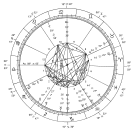Saturn return
| Astrology |
|---|
 New millennium astrological chart |
| Background |
| Traditions |
| Branches |
|
|
In horoscopic astrology, a Saturn return is an astrological transit that occurs when the planet Saturn returns to the same place in the sky that it occupied at the moment of a person's birth.[1][2] While the planet may not reach the exact spot until the person is 29 or 30 years old, the influence of the Saturn return is considered to start in the person's late twenties, notably the age of 27.[3]
Psychologically, the first Saturn return is seen as the time of reaching full adulthood, and being faced, perhaps for the first time, with adult challenges and responsibilities.[3]
In Western astrology
The phenomenon is described by Western astrologers as influencing a person's life development at roughly 29.5 year intervals, though the planetary influence may be felt for a few years before the exact conjunction, and variable orbits of the planets can also make the time period longer or shorter. These intervals or "returns" coincide with the approximate time it takes the planet Saturn to make one orbit around the sun, roughly 29.5 years. Western astrologers believe that, as Saturn "returns" to the degree in its orbit occupied at the time of birth, a person crosses over a major threshold and enters the next stage of life. With the first Saturn return, a person leaves youth behind and enters adulthood. With the second return, maturity. And with the third and usually final return, a person enters wise old age. These periods are estimated to occur at roughly the ages of 27-31, 56-60 and 84-90.[3] A fourth return occurs for very few people - those who live to see the age of 114-118.
In Hindu astrology
Jyotish (South Asian) astrology views Saturn's transits around the 12 houses of the Zodiac as important during these moments: the sade-sati or 7 1⁄2-year period, in which Saturn transits the houses before and after, as well as in, the house where the native's Moon lies. These seven and a half can often be difficult, and people go through difficulties and obstacles during these periods. Those with Capricorn, Aquarius and Libra Moons, however, see great progress, since Saturn rules the first two, and is exalted in the last sign. In addition, Saturn's transit through the Fourth and the Eighth Houses are also seen as important: known respectively as the dhaiya and astamashani periods.
See also
- 27 Club
- Return of Saturn, a music album by No Doubt and named after the phenomenon
Notes
- ↑ Saturn return at about.com
- ↑ Constance Stellas (2005). Advanced Astrology for Life. Adams Media. p. 77. ISBN 1593371977.
- 1 2 3 Greene, Liz (1976). Saturn: A New Look at an Old Devil.
References
- Schostak, Sherene; Weiss, Stefanie Iris (2003). Surviving Saturn's Return: Overcoming the Most Tumultuous Time of Your Life.
- Sullivan, Erin (2000). Saturn in Transit.